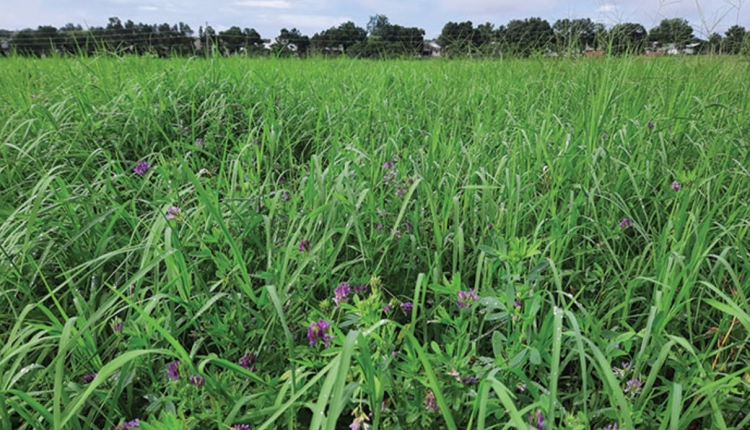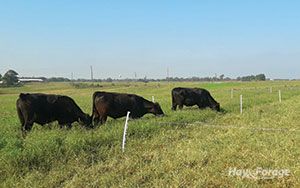Stockpiled alfalfa-bermudagrass helps cut purchased inputs |
| By Liliane Silva, Kim Mullenix, Jennifer Tucker |
|
|
|
Silva is an extension forage specialist with Clemson University. Mullenix and Tucker are extension beef specialists with Auburn University and the University of Georgia, respectively.  Stockpiling is an important management practice that defers forage availability for a time of later use. In the southeastern U.S., perennial grasses such as tall fescue and bermudagrass are used to extend forages use into the late fall and early winter to close the fall forage gap. Stockpiled bermudagrass provides moderate quality forage, but quality aspects may be improved with the incorporation of legumes. Growing alfalfa in bermudagrass stands provides a way to enhance seasonal forage production and nutritional value compared to bermudagrass alone. Alfalfa is a perennial forage legume with high forage production and quality. Over the last several decades, there was a decline in alfalfa acreage in the Southeast region associated with a harsh environment and elevated insect pressure. Joe Bouton, emeritus professor with the University of Georgia, developed new alfalfa varieties with improved adaptation to hot and humid growing conditions and with dual-purpose applications (haying and grazing) that better fit the environment and needs of livestock-forage producers in the region. Alfalfa can be grown either as a stand-alone crop or planted into warm-season perennial grasses in the region.  Strip grazing stockpiled alfalfa-bermudagrass mixtures in the fall can eliminate the need for feed supplements and purchased nitrogen fertilizer. A good fit The combination of a long growing season and the potential for delayed hard freeze conditions lends itself to potential success of an alfalfa stockpile system in the Southeast region. To begin assessing feasibility of this system, a two-year, multi-state research trial was conducted in Georgia and Alabama to evaluate different stockpiling strategies of alfalfa-bermudagrass mixtures. Five stockpiling periods (6, 8, 10, 12, or 14 weeks) were used to determine forage production, quality, composition, and stand persistence over time. Alfalfa-bermudagrass mixtures were mowed in late August or early September each year and stockpiled for the corresponding period. In Alabama, preliminary results showed average forage production ranging from 1,352 to 3,030 pounds of dry matter per acre across the five stockpiling periods during the two years of the trial (see figure).  In the second year, greater forage mass was observed for 10- and 12-weeks of regrowth (3,817 and 3,785 pounds of dry matter per acre, respectively). This response was associated with greater bermudagrass presence in the mixture. In Year 1, bermudagrass was 23% of the mixture and increased to 57% of the stand in Year 2. The percentage of weeds in the stockpiled mixture remained below 4% in both years. As the stockpiling period lengthened, greater alfalfa plant lodging and leaf shattering was observed (see table). Less alfalfa leaf presence impacts forage nutritional value, and it may impact performance when animals are consuming more mature alfalfa-bermudagrass mixtures. Similarly, greater forage digestibility was associated with a shorter regrowth period (six weeks), although the values observed across all stockpiling period lengths ranged from 62% to 87%. This represents a forage quality that can still meet high-end animal requirements, such as that for growing calves.  Based on these preliminary results, stockpiling alfalfa-bermudagrass mixtures using varying accumulation period lengths may be a viable alternative system to provide high-quality feed and extend the grazing season into the fall and winter months in the Southeast. This strategy might help reduce the reliance of off-farm inputs such as feed supplements and commercial nitrogen fertilizer. Incorporation of legumes into forage systems, such as alfalfa, will enhance diversity, resilience, and sustainability of forage-based livestock systems while lowering the carbon footprint. Additional resources As part of a regional effort among the University of Georgia, Auburn University, and the University of Florida, several decision-making resources have been developed to help producers determine if alfalfa might have a place on their operation. First, look at the “Alfalfa in Bermudagrass Checklist” on the Southeast Cattle Advisor website. This step-by-step guide will help determine site suitability for alfalfa establishment and the timeline needed for getting started. Next, review the informational webinars on this topic related to establishment, management, and economics, which are available at www.aces.edu/go/1734. This article appeared in the February 2022 issue of Hay & Forage Grower on pages 28 & 29. Not a subscriber? Click to get the print magazine. |
